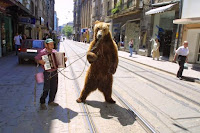Animal Cruelty:
Young bears are captured in the wild, separated from their
mothers, and taught by a trainer to become dancing bears in conditions of
unimaginable cruelty.
The young animals are forced onto sheets of glowing hot
metal and, in order to escape the pain, the bears alternate lifting up one paw
and then another while a music is played. The process is repeated again and
again until the animals automatically begin to raise their paws - to
"dance" - in fear of the pain, even when there are no metal sheets.
As the bears get older the trainers keep them under control
by inflicting pain. They do this by putting rings through the bears' highly
sensitive noses and jaws. No anaesthetic is used for this painful process.
Chains are attached to the rings so that the trainers can control the animals,
which weigh up to 350 kilograms, with only a slight tug on the chains.
The bear’s claws are trimmed several times a year and their
teeth broken or removed so they can’t injure their trainer. The bears also
suffer with an inadequate diet that usually consists of white bread, sugar and
alcohol. All these cause serious physical health problems for the bears. Many
also display stereotypic behaviours such as swaying and pacing and
self-mutilation as they can’t follow natural behavioural patterns and
instincts.
Petra, also
known as the Rose City due to the colour of the stone from which it is carved,
is one of the most famous and beautiful landmarks in the Middle East, renowned
worldwide for its unique rock-cut architecture.
Every year
thousands of tourists flock to the ancient city, which is a UNESCO World Heritage
site, and was elected one of the New Seven Wonders of the World in 2007.
The working
days are far too long and many of the animals also have no shade from the sun,
as well as insufficient regular fodder and water, quiet places in which to rest
and retreat. The animals also have limited access to veterinary care and suffer
from exhaustion, lameness and colic.
“We don't believe animals should be subjected to the
conditions of circus life. Regular transport, cramped and bare temporary
housing, forced training and performance, loud noises and crowds of people are
often unavoidable realities for the animals.
Scientific research has shown that travelling circus life is
likely to have a harmful effect on animal welfare.
Do circuses
still use animals?
Some circuses in Britain currently tour with wild animals,
including zebras, lions, snakes, tigers and camels.
Circus animals are
protected by the Animal Welfare Act. Wild animals must be licensed but there is
no law to stop circuses using certain types of animals.
The government in Westminster announced a ban in March 2012
on wild animals in circuses in England, with a licensing scheme in the interim.
We are seriously concerned about the lack of firm commitment to a timetable for
implementing a ban.
Worryingly, a report produced by the EFRA select committee of
MPs questioned the need to ban all wild animals from circuses, and even assumes
the public only care about the more iconic, charismatic wild animals, like
tigers and elephants.
The
Welsh Government has indicated it will allow the government in England to pass
legislation to regulate circuses in Wales.”
‘Zoo Check’
“The Welfare
of Animals in Captivity
Whether in zoos, circuses, animal shows or marine parks, wild
animals suffer physically and mentally from the lack of freedom that captivity
imposes.
Born Free believes such confinement and exploitation should
be a thing of the past.
The Zoo Check programme is at the heart of Born Free, and
since 1984 has worked to prevent captive animal suffering and phase out zoos.”





No comments:
Post a Comment